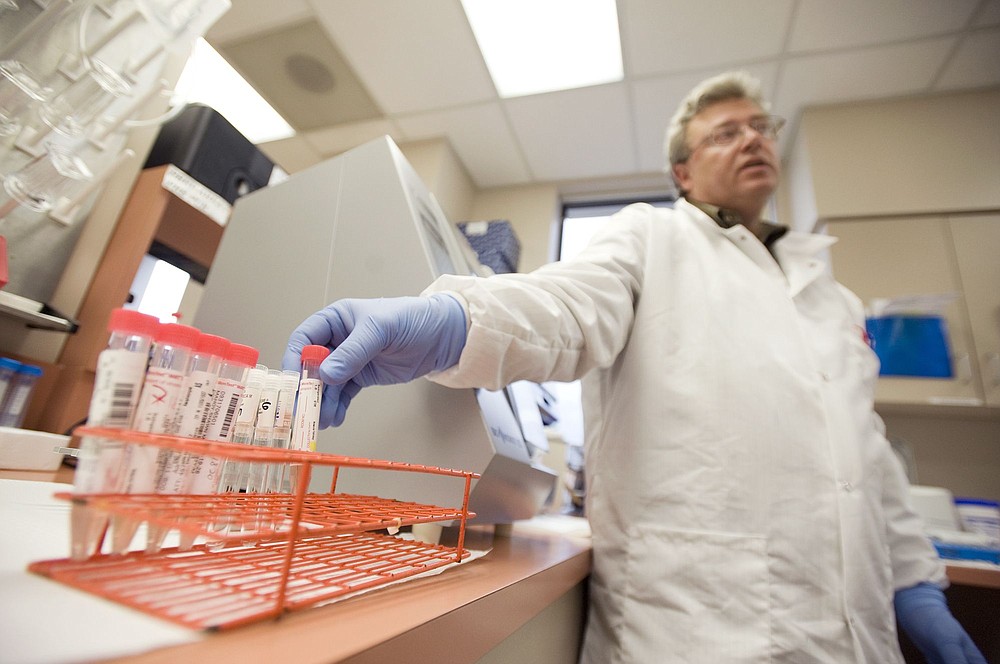This particular battle against H1N1 influenza starts by creating lots and lots of it.
On a molecular level, anyway.
Rapid duplication of its DNA sequence helps identify swine flu much faster. That helps doctors choose appropriate treatment for at-risk swine flu patients who have other severe health issues.
And once flu season has abated, the same molecular testing can provide more precise treatment options for other diseases.
The process is known as a polymerase chain reaction. The laboratory at Southwest Washington Medical Center has been doing the testing for about two weeks, and it’s come in handy during the swine flu outbreak.
With in-house testing, doctors learn if their patients have swine flu within seven hours or so.
Before the hospital’s lab started doing the molecular testing, samples of suspected swine flu were sent to the state’s public health laboratory. It took 10 days or more to get results, said Curt Gleaves, the hospital’s chief molecular scientist.
“You can guide therapy work if you start within 48 hours,” said Dr. Brad Jensen, director of the hospital’s department of pathology and laboratory medicine. “You can isolate patients.”
Originally, confirmation of the H1N1 virus through polymerase chain reaction was only done by the federal Centers for Disease Control and Prevention. The process still is not widely available. Jensen said his hospital has the only community-based lab in the Portland-Vancouver area doing its own molecular H1N1 testing.
According to www.genome.gov, significant amounts of DNA are necessary for molecular and genetic analyses. Polymerase chain reaction — sometimes called “molecular photocopying” — is a fast and inexpensive way to copy small samples of DNA.
The process starts with a sample collected with a nasal swab, throat swab or — in the case of an infant — a nasal suction bulb.
The sample is placed into an extractor, which draws DNA into a tube, said Gleaves, who came to Southwest Washington Medical Center in July from Providence Portland Medical Center in Portland. Gleaves also has worked at the Mayo Clinic and the Fred Hutchinson Cancer Research Center in Seattle.
The sample is heated so the DNA separates into two pieces of single-stranded DNA. An enzyme uses the two original strands as templates to build two new complete strands of DNA that duplicate the original sample.
Each new strand can be stripped apart to create two more duplicates; the process can create more than a billion exact copies of the original DNA segment, according to www. genome.gov.
The amplified sample goes through a three-part test. The first step tests for universal influenza A, which could be anything from H1N1 to a seasonal flu to dog influenza, Gleaves said.
The next step tests for H1N1; the third step is a control measure, testing for human genes.
All three steps have to be positive to signify a patient with H1N1 influenza, Gleaves said.
In addition to quicker turnaround time, a polymerase chain reaction is more accurate than growing cultures in a test tube.
“A culture is 85 to 90 percent sensitive and 97 percent specific, which identifies that it’s there and then ensures that it’s true,” Gleaves said.
With a polymerase chain reaction, sensitivity is 97 percent or better, while specificity is 99 percent or better, Gleaves said, noting that nothing is 100 percent.
“If a lot of disease is around, 85 percent is OK,” Jensen, the laboratory director, said. “But at the beginning or the end of an outbreak, sensitivity and specificity is important.”
Adding the polymerase chain reaction capability didn’t require a require a major investment. The lab added a couple of pieces of equipment, and got some set-up help from the state Department of Health.
Two experienced medical technicians trained in molecular techniques also helped build what Jensen called the “critical mass” that made it possible.
In addition to its use in microbiology, the polymerase chain reaction lab will help treat other diseases. They include high-profile problems such as HIV, hepatitis C and pertussis.
“It’s also very good for cancer diagnosis. That’s a DNA disease,” Jensen said.
“It’s an exciting area: personalized medicine. You can make drugs knowing what the problem is,” Jensen said. “A good example is Gleevec,” a cancer-fighting drug developed at Oregon Health & Science University.
Polymerase chain reaction testing can be used in treating blood disorders and in identifying genetic diseases before symptoms appear, Jensen said.
The testing still is in its early stages, Jensen said. He likened it to “where we were with antibiotics when they were introduced before World War II.”




